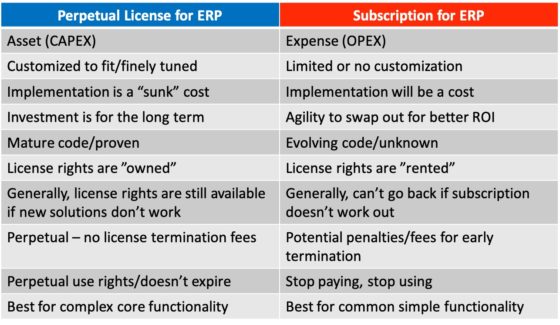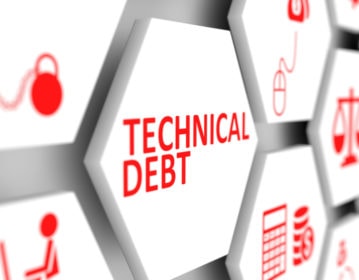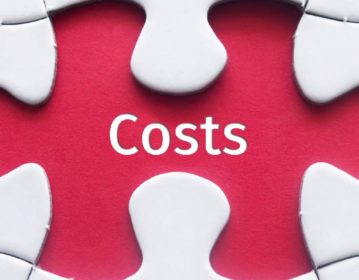
Your software is an asset. Software vendors such as Oracle and SAP are pressing licensees to replace existing enterprise applications in order to move to the vendor’s new platform. Yet, most companies have invested millions in their current ERP systems on targeted applications – Financials, Supply Chain, Distribution, Manufacturing, Human Capital Management, or Customer Experience to name a few – that provide a strong foundation for digital transformation or innovation. In many situations, if you have perpetual licenses, you shouldn’t swap them out for anything new.
ERP SaaS vs License: Pros and Cons
A paid-for software license can have enormous value
A company’s software licenses are assets. In most cases, the software has been customized to fit the business. After evolving and maturing over decades, it now fits like a glove. For many, the investment is likely in the millions of dollars after adding add up the licenses, implementation costs, and customizations. Using an automotive analogy, enterprise software is like driving a finely tuned car; if it is phenomenal after being customized over time to your exact specifications, why get rid of it? Instead, you can continue to nurture and maintain it.
Often, enterprise software licensees have perpetual rights and can continue using such software indefinitely. Continuing the auto analogy, drive it as long as possible. Systems such as SAP’s Business Suite 7 or Oracle’s EBS are generally stable and require minimal change. If well taken care of, they could run great for another 15 or more years.
Once these stable systems are optimized, they can provide tremendous flexibility for making other IT investments. They forge a strong foundation for propelling the business forward on its roadmap to the cloud, for digital transformation initiatives, or innovation that supports business goals. It’s likely best to keep driving that finely tuned system while investing elsewhere instead of waiting idly in the dealership mechanic’s shop not going anywhere for three or more years while a platform change crawls along to a maturity level worth implementing.
Subscriptions have different ownership and usage rights
Software subscriptions (SaaS) are a great way to help deploy functionality that delivers competitive advantage. Subscribe to software that will help differentiate the business – add around the edges of ERP to improve the customer experience or increase customer engagement.
These types of “edge” projects can be done relatively quickly and without much up-front investment. They can provide the agility to adopt different options, so you can keep the solutions that add value and swap out those that aren’t providing adequate return on investment.
The attributes of subscription model are often very different from perpetual licenses. With subscription-based licenses, customers generally pay a monthly or annual fee to continue using the software. In many cases it’s like leasing a new car, except there is no buy-out option at the end; once you stop paying – you stop driving. The model may be acceptable for smaller-scope solutions, but when this analogy is applied to ERP systems, it can create a high-risk scenario if the new leased car is not as good a value as the well-seasoned, customized car. Imagine buying a new Tesla where you lose functionality – it wouldn’t be as fast or have as many features as the older model Tesla – and it costs more money over time than the older Tesla. That would be unthinkable, wouldn’t it? But a similar scenario is possible with enterprise software because software vendors have a tendency to come out with new platforms that are seemingly not ready for prime time or not as good as the older platforms, particularly when those older platforms have been integrated with other systems and customizations that support business needs. This is why companies very often run releases of software that are 5-10 years old. They are stable, secure, and feature-rich!

Going back to the perpetual license can be extremely difficult, particularly if the new Cloud or SaaS platform does not live up to expectations – and there can be penalties and fees for early termination of the Cloud or SaaS subscription contract, just like backing out of a car lease.
Converting from a perpetual license to SaaS can be costly. For example, given many ERP software implementations have a history of cost and time overruns, customers should be wary of fees for extensions to the transition period in case the ERP SaaS implementation takes longer than planned. Also, ongoing costs can add up over time: price increases at contract renewal and extra fees/charges for alleged over-use are examples of the extras that add to the total cost of ownership. There is also the risk of over-subscribing. While scaling up and down is touted to be easier with subscriptions, customers can get locked into minimum subscription pricing that is larger than needed.

Considerations as you map your software strategies
- Evaluate whether the cloud is really a better solution for your enterprise software “right now” given the opportunity cost of what you could do with the funds instead (e.g. investing in systems of engagement or moving your infrastructure to the public cloud with vendors such as AWS, Azure, or GCP). A few scenarios exist where it may make sense to switch to a new platform (similar to buying the latest model SUV). One example is moving your data center to the public cloud. Likewise, a subscription model for CX with Salesforce.com or HCM with Workday may make sense for some scenarios, but for many CIOs with a majority of their spend in back-office systems of record, there is still plenty of value left in their perpetual software licenses – running the tried and true pickup truck.
- Assess whether the risk of change is worth the potential reward. Sinking precious IT dollars into a subscription-based solution that, in the case of SaaS ERP software, is relatively immature poses significant risks that can weigh more heavily than the value of having ERP delivered as a service – this is not simply “an upgrade,” it is more than likely a very costly “rip and replace” implementation. The IT strategy should be laser-focused on investments that enable the business strategy, provide competitive advantage, or enable growth. Consider optimizing your existing software assets with strategies such as “lift and shift” of applications to IaaS in the public Cloud.
- Look at whether a coexistence strategy can move you along your cloud roadmap without jeopardizing the benefits of your perpetual licenses. With a coexistence strategy, the licensee can keep a portion of the perpetually licensed product and replace the rest with a comparable cloud product. It enables strategic investments in new technology, limits the risks of replacing core ERP, and allows for licensees to keep benefiting from their perpetual licenses.
- Don’t use the subscription model to fix a problem you don’t have. In other words, don’t do an ERP SaaS refresh just because the vendor says its new platform delivers a digital core. Existing perpetual licenses are a tremendous asset that you can leverage. They provide stability, flexibility, and a strong foundation, giving you the ability to focus on innovation without the cost of switching platforms.
Key Takeaways
Continuing on the path of the automobile analogy, taking good care of your car, and driving it for years may be the best value. If that is the route you choose, make sure that you have the services that will allow that customized car to keep rolling.











